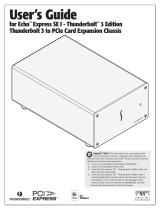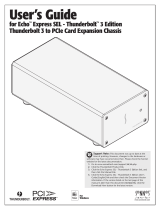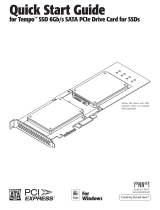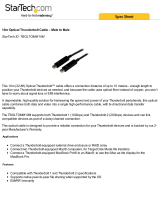Page is loading ...


1 Introduction and System Requirements 1
2 Echo Express III-R Description 2
3 PCIe Card Installation and Chassis Setup Steps 4
4 Verify Connections Using OS X System Information 8
A – Verify Echo Express III-R is Recognized
B – Verify Installed Cards are Recognized
5 Tips, General Information, and Known Issues 9
Tips, General Information
Known Issues
6 Specifications, Precautions, FCC Compliance, and Support Information 10
Specifications
Safety Precautions
FCC Compliance
Contacting Customer Service
Visit Our Website
A BNC Connector Installation Steps A
Contents

This page left intentionally blank

Chapter 1 – Introduction and System Requirements
1
Congratulations on your purchase! The Echo Express III-R is a Thunderbolt
2-to-PCI Express card expansion chassis. Through its PCIe slots, you may
connect three expansion cards to your iMac
®
, Mac
®
mini, Mac Pro
®
, MacBook
Air
®
, or MacBook Pro
®
with Thunderbolt technology to expand its capabilities
in ways never before possible! With its Windows
®
support, the Echo Express
III-R offers you a handy way to connect expansion cards to your desktop or
laptop PC with Thunderbolt technology.
Mac Compatibility
• Mac computer with a Thunderbolt 2 or Thunderbolt port
• OS X
®
10.8.5 or later
Windows Compatibility
• Windows PC with a Thunderbolt 2 or Thunderbolt port*
• Windows 10, 8, 7
System Requirements
While the Echo Express III-R chassis requires no drivers, the expansion cards
you install do; Thunderbolt-compatible drivers to enable it to work properly
through the Thunderbolt interface are required. More information on which
cards are compatible with Echo Express III-R is available at:
http://sonnettech.com/support/charts/thunderbolt/index.html
* To support more than two PCIe controllers, Windows requires a Thunderbolt
2 interface in both the computer and the expansion chassis. Note that some
PCIe cards have a bridge to multiple controllers, so it is possible for a single
dual-controller PCIe card to reach the limit if not connected via Thunderbolt 2.
Not all Mac-compatible PCIe cards are also compatible with Windows.

Chapter 2 – Echo Express III-R Description
1 – Power Indicator LED
This lights when: the Echo Express III-R is powered, the Thunderbolt cable between the chassis and your computer is
plugged in securely, and the computer powered on.
2 – Temperature-Controlled Fans
These provide cooling for the installed PCIe cards and
the chassis’ supporting Thunderbolt circuitry. They
operate at a whisper when the cards are running cool,
and automatically speed up in steps as the temperature
rises. Do not block the vent holes to prevent
overheating.
3 – Thunderbolt Ports
Connect a Thunderbolt cable between either port
and your computer’s Thunderbolt port (or other
Thunderbolt device in the chain connected to the
computer); the other may be used to connect to
another Thunderbolt device.
4 – BNC Connector Mounting Holes
These accommodate the installation of BNC
connectors like those used for HD/SDI output for the
RED ROCKET-X transcoding card, or for MADI and
word clock input and output from cards like RME’s
HDSPe MADI FX.
5 – Power Input Socket
Connect the included AC power cable here.
2

Chapter 2 – Echo Express III-R Description
Inner Assembly
1 – PCIe Card Bracket Locking Plate
This secures installed PCIe cards and port access covers.
2 – Port Access Covers
These cover openings in the chassis when PCIe slots are
unoccupied.
3 – Slot 1
This is an x8 electrical (x8 mechanical) PCIe 2.0 slot. It is also
compatible with PCIe 1.1 and 3.0 cards.
4 – Slot 2
This is an x8 electrical (x16 mechanical) PCIe 2.0 slot. It is also
compatible with PCIe 1.1 and 3.0 cards.
5 – Slot 3
This is an x4 electrical (x8 mechanical) PCIe 2.0 slot. It is also
compatible with PCIe 1.1 and 3.0 cards.
6 – Thunderbolt Interface Card
This card is installed in its own slot and may not be moved
to another slot.
7 – 6-Pin Auxilliary Power Connector
Plugged into this connector is the auxiliary power cable for
cards requiring extra power.
8 – PCIe Card Guides
When installing full-length cards, use these to support and
secure the cards.
9 – Thunderbolt Connector Retainer Clip
This secures a Thunderbolt connector plugged into the
Echo chassis’ Thunderbolt port to prevent accidental cable
disconnection. This clip is not compatible with optical
Thunderbolt cables.
10 – Thunderbolt Cable
Connect this cable between the Echo chassis and your
computer (or other Thunderbolt device in the chain
connected to the computer).
3

Chapter 3 – PCIe Card Installation and Chassis Setup Steps
1. Remove the Echo Express III-R from its packaging, and then set it on a
flat, level surface.
2. If necessary, adjust or remove the rackmount extension rails by
removing the four screws securing each one to the side of the enclosure.
As necessary, set the rails in place and secure them to the enclosure
with no fewer than two screws on each rail (Figure 1).
3. Using a Phillips screwdriver, remove and set aside the five screws
securing the inner assembly to the rackmount enclosure (Figure 2).
4. Push the back of the inner assembly into the enclosure, and then
gently pull out the inner assembly through the front of the enclosure
(Figure 2).
Figure 1
Figure 2
4

Chapter 3 – PCIe Card Installation and Chassis Setup Steps
5. OPTIONAL STEP: If you are going to install an optional Sonnet mobile
rack device mounting kit into the III-R, remove and set aside the six
screws securing the blank plate inside the enclosure, and then remove
and set aside the cover plate (Figure 3).
6. OPTIONAL STEP: Due to its size and weight, we recommend that you
install the empty rackmount enclosure now. If you don’t have full
access to the back of the rack into which you’ll install the III-R, or you
are installing an optional mobile rack device mounting kit into a III-R
that will reside in a mobile cart or rack, wait to install the assembled
III-R until instructed to do so.
7. Turn the inner assembly so the PCIe slots are facing up (Figure 4).
8. Loosen all three thumbscrews of the PCIe card bracket locking plate,
and then remove and set it aside (Figure 4).
9. Remove and set aside the port access covers (Figure 4).
Figure 3
Figure 4
5
Support Note: To avoid damaging components due to static
electricity discharge, wear an antistatic wrist strap while working
inside the Echo Express chassis.
WARNING: When handling computer products, take care to prevent
components from being damaged by static electricity; avoid working
in carpeted areas. Handle expansion cards only by their edges and avoid
touching connector traces and component pins. Also, avoid touching the
Echo chassis’ circuit boards and any of its components.

10. OPTIONAL STEP: If you are installing a PCIe card which requires
additional power and must be connected to auxiliary power, locate
the wire harness connected the 6-pin connector indicated in the
graphic to the right (Figure 5). Remove the cable twist tie securing the
wire harness, and move the loose connector aside for later connection.
Otherwise, go to the next step.
11. OPTIONAL STEP: If you are installing BNC connectors into the
chassis’ mounting holes, skip to the appendix at the end of the
document for instructions. Otherwise, go to the next step.
12. Remove a PCIe card from its packaging, handling the card by its edges
and without touching any components or gold connector pins.
13. Line up the card’s connector with the slot, and then gently but firmly
press the card straight into the slot; do not rock the card or force the
card into the slot. If you encounter excessive resistance, check the
card’s connector and the slot for damage, and then try inserting the
card again (Figure 6).
14. Repeat steps 12 and 13 as necessary with any remaining cards.
15. If you installed a card which requires auxiliary power, connect the
auxiliary power connector to it now. If you installed cables with BNC
connectors into the chassis, connect them to the card you installed.
16. If there are any unoccupied slots, install the port access covers you
removed previously (Figure 6).
17. Secure the cards and port access covers using the previously-removed
PCIe card bracket locking plate (Figure 6).
Slot 1 x8 (x8)
Slot 2 x8 (x16)
Slot 3 x4 (x8)
Chapter 3 – PCIe Card Installation and Chassis Setup Steps
Figure 5
Figure 6
6
Support Note: If you are installing an Avid Pro Tools|HDX PCIe
card, you will need to disconnect the Echo chassis‘ auxiliary power
wire harness plugged into the 6-pin connector indicated in Figure 5, and
replace it with the one included with the Avid card.
6-pin connector
Support Note: If you are installing an x8 PCIe 1.1 card like the
original Red Rocket (not Red Rocket-X), or certain 10 Gigabit
Ethernet cards, installing it into slot 3 may result in reduced performance.
We recommend you install it into either slot 1 or 2 for best performance.

18. OPTIONAL STEP: If you are also installing a Sonnet mobile rack
device mounting kit, refer to its user’s guide now for instructions
about installing it and the inner assembly. Otherwise, go to the next
step.
19. Gently push the inner assembly back inside the rackmount enclosure
(Figure 7).
20. Secure the inner assembly to the rackmount enclosure using the five
screws you removed previously (Figure 7).
21. If you haven’t already installed the Echo Express III-R into its rack, do
so now.
22. Connect the included Thunderbolt cable between either Thunderbolt
port on the Echo chassis and a Thunderbolt port on your computer,
or other Thunderbolt device in the chain connected to the computer
(Figure 8). Secure the retainer clip to the chassis if you attached it.
If you are daisy chaining additional Thunderbolt devices, connect
another Thunderbolt cable between the downstream device and the
open Thunderbolt port on the Echo chassis.
23. Connect interface cables between devices, PCIe cards, and computer
as necessary.
24. Connect the included power cord between a wall outlet or power strip
and the Echo chassis’ power socket. Note that the power indicator on
the Echo Express III-R will not light until the computer, and any other
Thunderbolt device connected between it and the Echo chassis, is
powered on.
Chapter 3 – PCIe Card Installation and Chassis Setup Steps
Figure 7
7
Figure 8
Support Note: Sonnet’s ThunderLok™ Thunderbolt connector
retainer clip secures the included Thunderbolt cable to the Echo
chassis to prevent accidental disconnects. Although it is compatible with
other copper Thunderbolt cables like Apple’s, it is not compatible with
optical Thunderbolt cables.
To attach the clip to the cable, remove them from their packaging, and then
insert the connector into the connector clip as shown (Figure 8). Note that
the connector will pass all the way through the clip; when you connect the
cable to the chassis, the clip will secure the cable.

A – Verify the Echo Express III-R is Recognized
1. With the Echo chassis powered and connected to the computer, turn
on the computer.
2. From the Apple menu, select About This Mac; the System Information
application will launch.
3. When the About This Mac window opens, click More Info; a summary
of specifications will appear.
4. Click System Report; a full report window will appear.
5. In the System Information window, click Thunderbolt under the
Hardware header in the left column (Figure 10).
6. In the top right column under the Thunderbolt Device Tree header,
you will see the computer, followed by “Echo Express III” (Figure 10).
B – Verify Installed Cards are Recognized
1. When a card is installed into one of Echo chassis’ PCIe slot(s), the
PCIe slot (listed as a port), the Status should appear as connected.
2. Click PCI Cards under the Hardware header in the left column
(Figure 11).
3. At the top of the right column, installed cards are listed. By selecting
a card at the top, detailed information is listed. You should see “Yes”
next to Driver Installed and Tunnel Compatible, otherwise the card or
driver may not be Thunderbolt compatible (Figure 11).
Chapter 4 – Verify Connections Using OS X System Information
Figure 10
Figure 11
8
Support Note: If “Echo Express III” is not listed, disconnect and
reconnect the Thunderbolt cable between the computer and Echo
chassis. Note that it is not necessary to shut down the computer before
disconnecting and reconnecting the cable.
Support Note: While Echo Express expansion chassis require no
drivers, installed cards require Thunderbolt-compatible drivers to
enable their use.

Replacing Cards or Adding Cards After Initial
Installation
If you decide to replace or add a card to the Echo Express
chassis after the initial setup, shut down the computer,
and then disconnect the power cord and Thunderbolt
cables before installing a card.
PCIe CARDS ARE NOT HOT-PLUGGABLE!
Never install a PCIe card into Echo Express while it is
connected to a computer or power outlet! If you do, you
risk injury, and damage to the card, chassis, and computer.
KNOWN ISSUES
Not all PCIe Cards Will Perform at 100%
Thunderbolt 2’s PCIe bandwidth is limited to 20Gbps.
While many cards will operate at full performance, some
may not due to the fact they require more bandwidth
than Thunderbolt is capable of delivering.
OS X Updates May Break Compatibility
Specific device drivers that work under one version of
OS X may not work under a later version. Before updating
to the latest OS, we recommend that you contact your PCIe
cards’ manufacturers to verify that the existing drivers
work with the new OS version. Note that other software
updates for the computer may also break compatibility.
Some Devices’ Performance May be Affected by Where
They Are Connected in a Thunderbolt Chain
However small, Thunderbolt introduces latency to a
device chain. If you expand with additional Thunderbolt
expansion chassis, you may need to experiment with
which cards work better in chassis closer to or farther from
the computer in the chain.
Thunderbolt Support Under Windows is Incomplete
At the time of this writing, Intel and Microsoft have not
settled on a certification standard for Thunderbolt devices
under Windows. The main unresolved issues are how hot-
plugging support and sleep mode support for Thunderbolt
devices are handled. Support for these features exists
under OS X, but is still in development under Windows.
While Thunderbolt-compatible cards will function in your
Echo expansion chassis when attached to your computer
at boot, we cannot guarantee how the Windows driver
will respond to hot-plugging of the Thunderbolt cable
after boot or how it will operate when returning from
sleep. While we do expect these issues to be resolved in
the future, at the present they are not.
TIPS, GENERAL INFORMATION
Keeping the Cards Cool
With its optimized airflow design and temperature-
controlled fans providing cooling at all times, the
Echo Express III-R provides adequate cooling for the
installed cards. Do not operate the Echo Express III-R with
the inner assembly removed, and do not block any of the
vents! Otherwise, the installed cards and Echo Express’
components may overheat.
Hot Plugging the Echo Express III-R – Mac Users
When certified Thunderbolt-compatible cards (used with
Thunderbolt-compatible drivers) are installed in Echo
Express III-R, you may connect and disconnect the chassis
while the computer is on. Of course, if you have anything
connected to the cards, such as storage devices, cameras,
etc., follow proper procedures for disconnecting those
devices before unplugging the Echo Express chassis.
There’s No Need to Unplug the Power Cable
Because the Echo Express III-R automatically powers on
and off with the computer to which it’s connected, there’s
no power switch, nor is there any need to disconnect the
power cable under normal use.
Power Indicator LED Operation
Because the Echo Express III-R automatically powers on and
off with the computer to which it’s connected, its power
indicator LED only turns on when the computer is on, and
turns off when the computer is sleeping or powered off.
Connecting Additional Thunderbolt Devices
You may connect up to six Thunderbolt devices total in a
daisy chain, including the Apple Thunderbolt Display.
Using Expansion Cards Without Drivers
Some Thunderbolt-compatible expansion cards, like
Sonnet’s Presto
™
Gigabit Pro PCIe and Sonnet’s Tempo
™
SATA Pro 6Gb eSATA cards, use drivers built into the OS.
Chapter 5 – Tips, General Information, and Known Issues
9

SAFETY PRECAUTIONS
Please read this section carefully before proceeding. These
precautions explain the correct and safe use of this device,
thereby helping to prevent injury to you or others, and also
help you to minimize the risk of damaging the device.
• Do not attempt to modify the enclosure. If this device
appears to be malfunctioning, contact your reseller or
local distributor.
• Do not drop the chassis; dropping or mishandling
chassis may result in a malfunction leaving the product
inoperable.
• Do not insert your fingers or foreign objects inside the
slot(s).
• Do not expose the device to rain, use it near water or
containers that contain liquids which might spill into
any openings, or in damp or wet conditions.
• If unusual smells, sounds, or smoke come from the
device, or if liquids enter it, unplug it from the electrical
outlet immediately.
• Follow the instructions in this manual carefully; contact
your reseller or local distributor for additional advice not
covered in this User’s Guide.
FCC Compliance
Echo Express III complies with Part 15 of the FCC Rules.
Operation is subject to the following two conditions: This
device may not cause harmful interference, AND this
device must accept any interference received, including
interference that may cause undesired operation.
Contacting Customer Service
The Sonnet Web site located at www.sonnettech.com
has the most current support information and technical
updates. Before you call Customer Service, please check
our Web site for the latest updates and online support files,
and check this User’s Guide for helpful information.
When you call Customer Service, have the following
information available so the customer service staff can
better assist you:
• Product name
• Date and place of purchase
• Computer model
• PCIe card models
• Operating system version
• Software/firmware versions
USA Customers
If further assistance is needed, please contact Sonnet
Customer Service at:
Tel: 1-949-472-2772
(Monday–Friday, 7 a.m.–4 p.m. Pacific Time)
E-mail: support@sonnettech.com
For Customers Outside the USA
For support on this product, contact your reseller or local
distributor.
Visit Our Web Site
For the most current product information and online
support files, visit the Sonnet Web site at www.sonnettech.
com/support/. Register your product online at http://
registration.sonnettech.com to be informed of future
upgrades and product releases.
Specifications
External Connectors • Two Thunderbolt
• One power (C14-type)
Internal Connectors 6-pin Mini-Fit Jr
Expansion Slots • One x8 mechanical (x8
electrical) PCIe 2.0
• One x16 mechanical (x8
electrical) PCIe 2.0
• One x8 mechanical (x4
electrical) PCIe 2.0
PCIe Cards Supported • One full-length, full-height,
double-width PCIe card,
plus one single-width card
or
• Three full-length, full-
height, single-width PCIe
cards
Compatible PCIe Cards See Sonnet Website
(www.sonnettech.com)
Power Supply Universal 300W, 115-230V
AC, 50-60 Hz
(1)
Operating Temperatures 0˚ C to 35˚ C
(32˚ F to 95˚ F)
Dimensions WxDxH 19 x 16 x 3.48 in.
(48.26 x 40.6 x 8.85 cm)
Weight 19 lbs
(8.6 kg)
RoHS Compliant Yes
Package Contents • Echo Express III-R chassis
• Power cord
• Thunderbolt cable
• ThunderLok Thunderbolt
connector retainer clip
(2)
• User’s guide
1. Power supply will operate at 90-115V AC, with linear power deration of
240W-300W over that range.
2. Not compatible with optical Thunderbolt cables.
Chapter 6 – Specifications, Precautions, FCC Compliance, and Support Information
10

1. Remove and set aside the two screws securing the
Thunderbolt interface card to the inner assembly
(Figure A-1).
2. Gently push down on the edge of the card to disengage the
card from its slot (Figure A-1).
3. Grasping the card by its edges, rotate the card out of the
inner assembly, and then pull it out (Figure A-2). Set aside
the Thunderbolt interface card on flat surface, component
side down.
4. Insert the BNC cables through the BNC connector
mounting holes in the inner assembly (Figure A-3). Route
the cables out over the top of the PCIe slot riser card.
5. Slide the connector nuts over the BNC cables, and then
secure the connectors to the inner assembly (Figure A-3).
6. Grasping the Thunderbolt interface card by its edges, insert
the card back into the inner assembly (Figure A-4).
7. Line up the card’s connector with the slot, and then gently
but firmly press the card straight into the slot; do not rock
the card or force the card into the slot. If you encounter
excessive resistance, check the card’s connector and the
slot for damage, and then try inserting the card again
(Figure A-5).
8. Using the two screws you removed previously, secure the
Thunderbolt interface card to the inner assembly; do not
overtighten the screws (Figure A-5).
9. Return to step 12 on page 6 to complete the PCIe card and
chassis setup steps.
Appendix A – BNC Connector Installation Steps
A
Figure A-1 Figure A-4
Figure A-2 Figure A-5
Figure A-3

©2015 Sonnet Technologies, Inc. All rights reserved. Sonnet, the Sonnet logotype, Simply Fast, the Simply Fast logotype, Allegro, Echo, and Tempo are trademarks of Sonnet Technologies, Inc. FireWire, Mac, the Mac logo, and OS X are trademarks of Apple Inc.,
registered in the United States and other countries. Thunderbolt 2 and the Thunderbolt logo are trademarks of Intel Corporation in the U.S. and/or other countries. Other product names are trademarks of their respective owners. Product specifications subject
to change without notice. Printed in the USA. UG-ECHO-EXP3FR-E-F-102715


/






